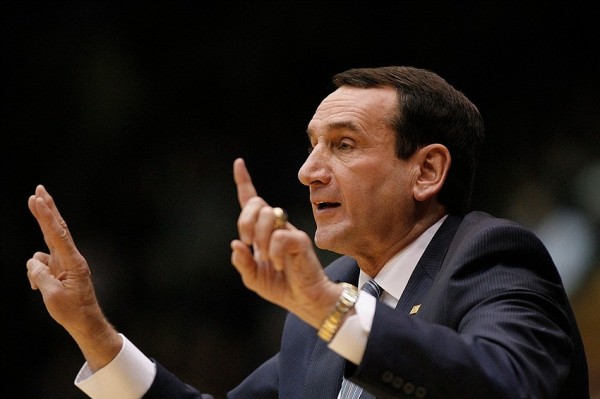Has Duke Found the Answer on Defense?
Posted by Brad Jenkins (@bradjenk) on December 28th, 2013Back in late November we wrote about Duke’s historically bad defense. At the time, the Blue Devils were coming off their worst defensive effort of the last 12 years, having given up 90 points on 1.38 points per possession in their home squeaker against Vermont. Head coach Mike Krzyzewski was extremely upset and vowed that great improvement must be made on the defensive end of the floor. Five games later, it’s now a good time to see how much progress Duke’s defense has made in the intervening month of action.

Coach Mike Krzyzewski Was Pleased With Duke’s Defense In Their Win Over UCLA
(Photo: Mark Dolejs – USA TODAY Sports)
Let’s take a more detailed look at the team’s defensive numbers from the first six Duke games through that dreadful Vermont performance on November 24. Then we will compare those statistics to what the Blue Devils have done in their last five games heading into the Christmas break. Here are the key defensive statistics from the first six games:
- 1.07 – Opponents’ Avg Points Per Possession for All Games
- 1.08 – Opponents’ Points Per Possession vs. Duke
By applying Ken Pomeroy’s principle of adjusting for competition, we come up with an Adjusted Defensive Rating of 1.05 PPP for Duke’s first six games. That number would currently put Duke’s defense at around #200 in the nation in Pomeroy’s ratings – lousy defense indeed. Now that’s look at the same metric for Duke’s last five games:
- 1.09 – Opponents’ Avg Points Per Possession for All Games
- 0.98 – Opponents’ Points Per Possession vs. Duke
Even though the competition was tougher, Duke’s raw defensive numbers were significantly better. This time when we account for competition, we get an Adjusted Defensive Rating of 0.93 PPP. That number would rank #12 in the current Pomeroy ratings. Clearly, Duke has made a dramatic improvement in its team defense.
The next step is to look at what changes were made and which areas improved the most. The most obvious change was in the starting lineup. Out came sophomores Amile Jefferson and Rasheed Sulaimon, and in came seniors Josh Hairston and Tyler Thornton. That gave Duke more of a defensive mindset early in each game and also sent a message to the sophomores that they better pick up their defensive efforts. Maybe that message has now been received as both Jefferson and Sulaimon earned spots on the floor down the stretch in last Thursday’s 83-60 win over UCLA. The next adjustment was more strategic. Coach K has described this change as pulling back from extended pressure in order to establish a solid base of halfcourt defense.
Now, let’s compare some key defensive statistics for each segment of the season:
Amazingly, despite an overall improvement in team defense, Duke is actually allowing opponents to shoot the same percentage from the field. They have overcome this deficiency by getting considerably better in the other areas shown above. Interestingly, the Blue Devils are forcing quite a few more turnovers even though they have dialed back the extended pressure. Also, contrary to how television announcers have labeled Duke as weak on the boards, the Blue Devils are a respectable #62 in the country in defensive rebounding, and that 23.6 percent opponents’ offensive rebounding rate in the last five games would rank fifth in Pomeroy’s current ratings. It’s also clear that fouling less often has been helpful to the Blue Devils’ cause.
To summarize, and echoing what Krzyzewski pointed out after the UCLA game, “November’s team is not the same as December’s team, and December’s won’t be the same as January’s and February’s teams.” The facts clearly support the notion that Duke’s defense was terrible early and has been elite lately. But that doesn’t guarantee that Duke will maintain this new and improved defense into 2014. A major concern remains that opponents have been able to make shots at such a high percentage against the Devils. Duke currently ranks #152 in the nation in defensive effective field goal percentage at 48.9 percent, and without a rim-protecting big man in the rotation, it is likely to remain a weakness, which means Duke will have to be great at everything else to avoid defensive breakdowns.
While they have managed to improve over a five-game stretch, doing so over the long 18-game ACC schedule will be quite another challenge. Perhaps a realistic expectation will be for Duke to improve its defensive efficiency into the top 25. That sounds like a tall order since they rank 62nd now, but consider that they were much worse before the UCLA game, so big jumps are possible with impressive performances against good offenses. One final statistical point concerns the Duke offense. The new emphasis on hand-checking fouls has resulted in a slightly adverse effect as Duke’s’ scoring dropped from 93 PPG in the first six games to 77 PPG in the last five. But due to Duke’s higher level of December competition, the team still ranks second in Pomeroy’s offensive efficiency ratings. The defense doesn’t have to carry this year’s team, but it will need to maintain consistently solid play for Duke to become the national contender everyone anticipated.











































